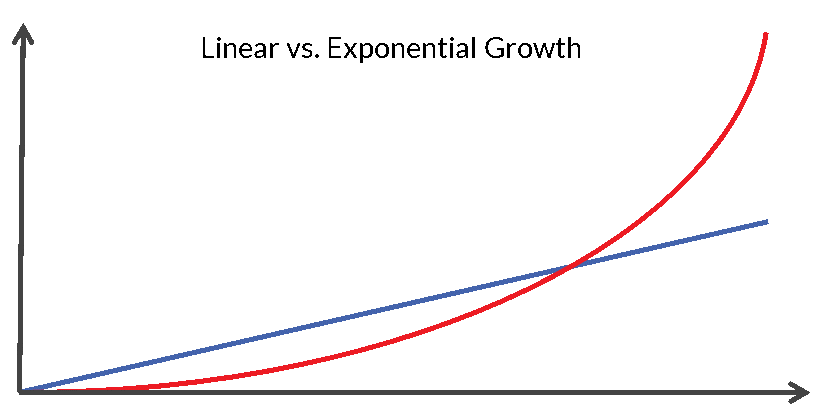The original article was published on MoreThanDigital.info: Exponential Change due to Exponential Growth
Deciphering the speed of technological development
We live in an era of relentless acceleration. The world around us is changing at a breathtaking pace, driven largely by technological advances. Often called ‘exponential change’ or ‘exponential growth’, this phenomenon is profoundly reshaping our society and business landscape. Let’s look at how this rapid development works, what it means and the resulting implications for society and the economy.
Linear vs. exponential growth: a conceptual divergence
Human perception naturally tends towards linear progression – thinking in terms of sequences such as 1, 2, 3 and so on. This intuitive approach contrasts sharply with the concept of exponential growth, which follows a sequence such as 1, 2, 4, 8, 16. The exponential framework – characteristic of many technological advances – is less intuitive, as evidenced by the fact that few can easily calculate that 2 to the power of 10 equals 1024. This discrepancy between human intuition and computational reality underlines the transformative potential of technology, which can be seen in areas ranging from digital platforms to algorithmic advances.

The criticality of exponential growth
The impact of exponential growth has become increasingly apparent in recent years. Consider how the iPhone evolved since it debuted in 2007. In just seven years, its computing and graphics capabilities have grown exponentially, reflecting a broader trend across the technology spectrum. This acceleration is critical as technology becomes more integrated into all aspects of daily life, creating both opportunities and challenges for businesses.
Exponential growth in the business world
This exponential growth is mirrored in the business world. Every year, new technologies are introduced that redefine product development, service delivery and operational efficiency. In this digital age, the concept of digital transformation has evolved to describe the wholesale integration of these technologies into business practices – a transition that requires organisations to be adaptable and strategically forward thinking.
Scalability: a critical dimension to success
Amazon’s ongoing evolution is an example of how organisations can leverage technology for scalability. This can turn challenges into opportunities. Scalability – the ability to expand services or products without increasing operational costs – is key to sustaining and growing digital business models. This principle underpins the shift from traditional, non-scalable business models to those that can efficiently serve a growing customer base without a proportional increase in costs or resources.
Diverse industry transformations
The shift towards scalable, technology-driven models can be seen in a number of industries. Consulting firms are actively exploring digital ways to improve scalability and efficiency, as are the pharmaceutical and healthcare industries and the fitness sector. These changes highlight the broad applicability and potential of technology integration across different sectors.
Addressing the challenges of exponential growth
Despite its many benefits, exponential growth also brings with it significant challenges, including ethical dilemmas, privacy concerns, cyber security risks, economic displacement and the widening of the digital divide. These challenges require a proactive and multi-faceted response from all stakeholders to ensure that the benefits of technological progress are harnessed fairly and responsibly.
Embracing change as the new normal
To sum up, sustainable business success within this fast-moving landscape means embracing change as a constant. Businesses need to cultivate a culture of adapting, experimenting and responding to new trends and technologies. The ability to innovate and adapt will define tomorrow’s leaders as exponential growth reshapes the future.

